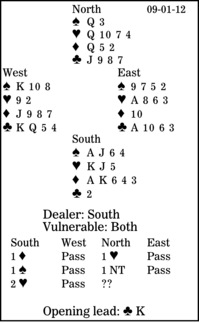Bridge column, September 1: More on opener's bidding three suits

At the bridge table, ask yourself what you could do. You are not allowed to read a book or ask someone else until afterward.
In today's deal, though, you can work out the right answer by understanding partner's sequence.
Look at the North hand. South opens one diamond, you respond one heart, South rebids one spade, you opt for one no-trump, and South continues with two hearts. What would you do now?
Your sequence showed 6 to 9 points with four (perhaps five) hearts, fewer than four spades and at least one club stopper. But what has South described?
By bidding a third time, he is saying that game is still possible. He ought to have 16 or 17 points. And his hand distribution should be 4-3-5-1 (or 4-3-6-0).
So, two hearts is a 4-3 fit. Those fits are fine when the hand with three trumps has a ruffing value (singleton or void) and the trumps are strong. Here, two hearts will make, but it looks safer to run to the eight-card fit, signing off in three diamonds.
West leads the club king, then continues with the club four. After ruffing, South should play the heart king. In danger of losing trump control, declarer should get a heart winner or two established, happy to lose one trick in each suit. But in this deal, several lines work.
** ** **
COPYRIGHT: 2012, UNITED FEATURE SYNDICATE
DISTRIBUTED BY UNIVERSAL UCLICK FOR UFS

